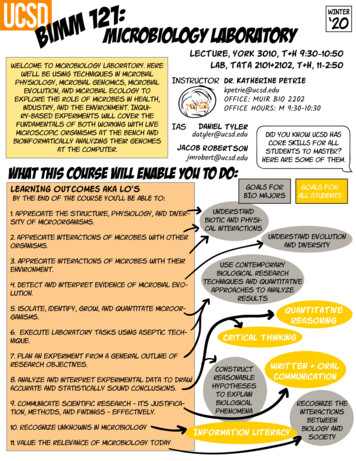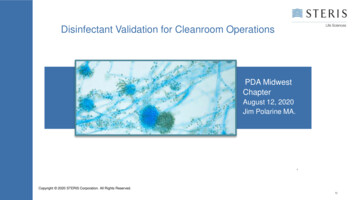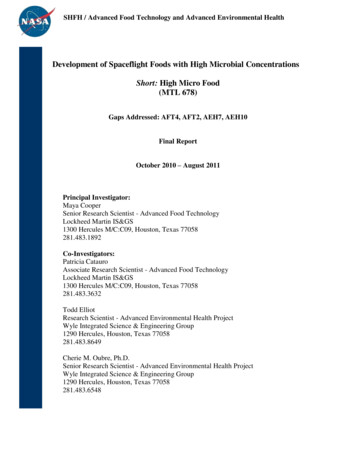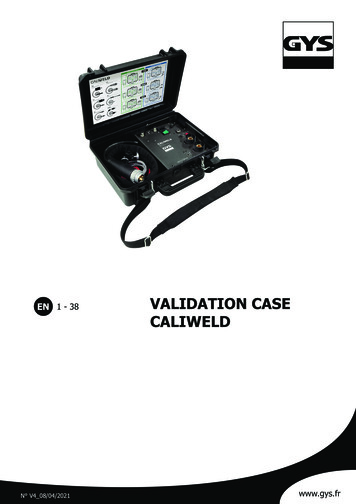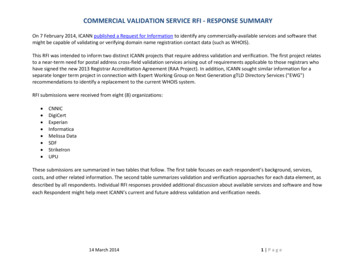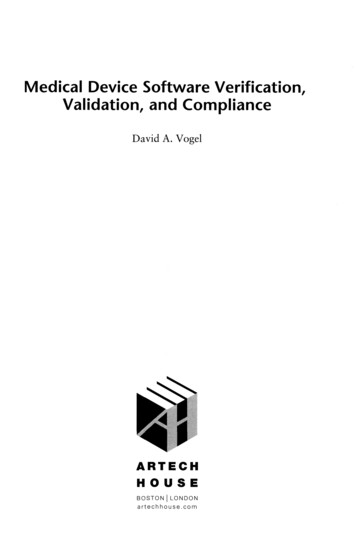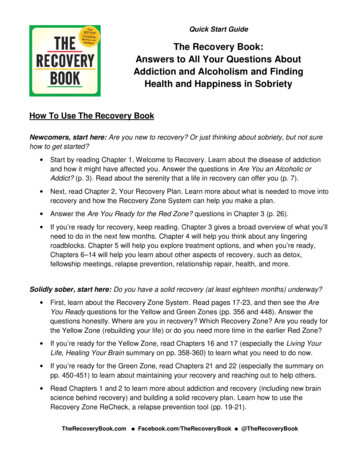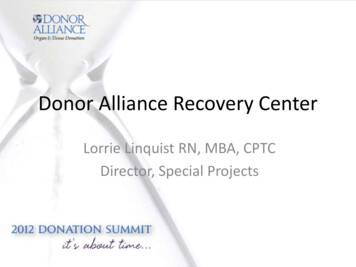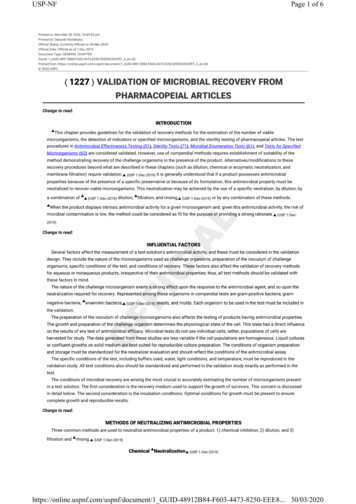
Transcription
USP-NFPage 1 of 6Printed on: Mon Mar 30 2020, 16:40:04 pmPrinted by: Deborah NishikawaOfficial Status: Currently Official on 30-Mar-2020Official Date: Official as of 1-Dec-2019Document Type: GENERAL CHAPTERDocId: 1 GUID-48912B84-F603-4473-8250-EEE8533D39FF 3 en-USPrinted from: https://online.uspnf.com/uspnf/document/1 GUID-48912B84-F603-4473-8250-EEE8533D39FF 3 en-US 2020 USPC〈 1227 〉 VALIDATION OF MICROBIAL RECOVERY FROMPHARMACOPEIAL ARTICLESChange to read:INTRODUCTION This chapter provides guidelines for the validation of recovery methods for the estimation of the number of viablemicroorganisms, the detection of indicators or specified microorganisms, and the sterility testing of pharmacopeial articles. The testprocedures in Antimicrobial Effectiveness Testing 〈51〉〉, Sterility Tests 〈71〉〉, Microbial Enumeration Tests 〈61〉〉, and Tests for SpecifiedMicroorganisms 〈62〉〉 are considered validated. However, use of compendial methods requires establishment of suitability of themethod demonstrating recovery of the challenge organisms in the presence of the product. Alternatives/modifications to theserecovery procedures beyond what are described in these chapters (such as dilution, chemical or enzymatic neutralization, andmembrane filtration) require validation. (USP 1-Dec-2019) It is generally understood that if a product possesses antimicrobialproperties because of the presence of a specific preservative or because of its formulation, this antimicrobial property must beneutralized to recover viable microorganisms. This neutralization may be achieved by the use of a specific neutralizer, by dilution, bya combination of (USP 1-Dec-2019) dilution, filtration, and rinsing, (USP 1-Dec-2019) or by any combination of these methods. activity, the risk of (USP 1-Dec-2019)Change to read:these factors in mind.negative bacteria, anaerobicthe validation.The specific conditions of the test, including buffers used, water, light conditions, and temperature, must be reproduced in thevalidation study. All test conditions also should be standardized and performed in the validation study exactly as performed in thetest.The conditions of microbial recovery are among the most crucial in accurately estimating the number of microorganisms presentin a test solution. The first consideration is the recovery medium used to support the growth of survivors. This concern is discussedin detail below. The second consideration is the incubation conditions. Optimal conditions for growth must be present to ensurecomplete growth and reproducible results.Change to read:METHODS OF NEUTRALIZING ANTIMICROBIAL PROPERTIESThree common methods are used to neutralize antimicrobial properties of a product: 1) chemical inhibition, 2) dilution, and 3)filtration and rinsing. (USP 1-Dec-2019)Chemical Neutralization (USP /1 GUID-48912B84-F603-4473-8250-EEE8. 30/03/2020
USP-NFPage 2 of 6Table 1 shows known neutralizers for a variety of chemical antimicrobial agents and the reported toxicity of some chemicalneutralizers to specific microorganisms. However, despite potential toxicity, the convenience and quick action of chemical inhibitorsencourage their use. Chemical neutralization of antimicrobial agents (USP 1-Dec-2019) is the preferred method for the antimicrobialefficacy test. The potential of chemical neutralizers (USP 1-Dec-2019) should be considered in the membrane filtration and the direct inoculation (USP 1-Dec-2019) sterility tests. Antibiotics may not be susceptible to neutralization by chemical means, but rather byenzymatic treatment (e.g., penicillinase). These enzymes may be used where required.Table 1. Some Common Neutralizers for Chemical Antimicrobial Agents (USP 1-Dec-2019)Potential Action of Antimicrobial NeutralizerAntimicrobial (USP 1-Dec-2019) ClassBisulfateGlutaraldehyde, mercurialsDilutionPhenolics, alcohol, aldehydes, sorbateGlycineAldehydesAgents (USP 1-Dec-2019)Non-sporing bacteria—Growing cellsQuaternary ammonium compoundsLecithin(QACs), parabens, bis-biguanidesMg 2 or Ca 2 osulfate antimicrobial agent (USP 1-concentration and antimicrobialwith the general formula:C concentration ηt versus log Ctk a constantη values are not goodTable 2. Concentration Exponents for Some Common Antimicrobial AgentsIncreased Time Factor (x) to Kill Microorganisms When theConcentration Is Reduced to:Representative AntimicrobialAgentη e.uspnf.com/uspnf/document/1 GUID-48912B84-F603-4473-8250-EEE8. 30/03/2020
USP-NFPage 3 of 6Increased Time Factor (x) to Kill Microorganisms When theConcentration Is Reduced to:Representative AntimicrobialAgentη ValuesOne-HalfOne-Third123pounds123Formaldehyde123 (USP 1-Dec-2019)Mercury compoundsQuaternary ammonium com-Membrane FiltrationAn approach that is often used, especially in sterility testing, is neutralization by membrane filtration. This approach relies upon thephysical retention of the microorganism on the membrane filter, with the antimicrobial agent passing through the filter into thefiltrate. The filter is then incubated for recovery of viable microorganisms. However, filtration alone may not remove sufficientquantities of the antimicrobial (USP 1-Dec-2019) agent to allow growth of surviving microorganisms. Adherence of residualantimicrobial agents to the filter membrane may cause growth inhibition. Filtration through a low-binding filter material, such aspolyvinylidene difluoride, helps to minimize this growth inhibition. Additionally, the preservative may be diluted or flushed from thefilter by rinsing with a non-toxic (USP 1-Dec-2019) fluid, such as diluting Fluid A (see Sterility Tests 〈71〉〉, Diluting and Rinsing Fluids forMembrane Filtration for diluting fluid compositions). Chemical neutralizers in the rinsing fluid can ensure that any antimicrobialresidue on the membrane does not interfere with the recovery of viable microorganisms.Change to read:neutralizer non-toxicity. employed is effective in( lack of (USP 1-Dec-2019)recovery results fortreatment groups.Membrane Filtrationis used without exposure to non-toxicity. (USP1-Dec-2019)In the tests under 〈51〉〉 and 〈61〉〉, (USP 1-Dec-2019) the number of viable challenge microorganisms in the product is estimated (USP 1-Dec-2019) by calculating the concentration of cfu per milliliter by the plate count method. A design for validating neutralizationwould incorporate the treatment groups as described under Validation of Neutralization Methods—Recovery Comparisons. At leastthree independent replicates of the experiment should be performed, and each should demonstrate a mean count of any of the testorganisms not differing by a factor greater than 2, i.e., 50%–200% recovery, from the value of the control in the absence of product. Ifit is necessary to solubilize the test sample, (ERR 1-Dec-2019) the effects of the solubilization method on viable microorganismsmust be determined. This situation can occur when testing ointments, suspensions, or other articles. (USP 1-Dec-2019)If a greater number of replicates is required in the validation study, the comparisons may be evaluated by transforming thenumbers of cfu to their logarithmic values and analyzing the data statistically by the Student t test (pairwise comparisons) or byanalysis of variance (ANOVA) (for comparing all groups). If ANOVA is used, and significant differences among the populations aredetermined, a test such as Dunnett's test may be used, with the peptone group used as the control group.Recovery by Membrane 1 GUID-48912B84-F603-4473-8250-EEE8. 30/03/2020
USP-NFPage 4 of 6This validation follows the procedure described in Sterility Tests 〈71〉〉, Method Suitability Test, (USP 1-Dec-2019) with the exceptionof plating on solid medium to quantitate recovery. It should be emphasized that quantitative recovery is not required todemonstrate sterility test suitability. It only requires a qualitative assessment (visual turbidity). (USP 1-Dec-2019) Three 100-mL rinsesare assumed, but the volume and number of rinses are subject to validation. A maximum of five 100-mL washes should be used forroutine testing even if during method suitability it has been demonstrated that such a cycle does not fully eliminate the antimicrobialactivity. (USP 1-Dec-2019)Each validation run should be performed independently at least three times.In the test solution group, the product is passed through the membrane filter, followed by two 100-mL portions of dilutingneutralizing fluid. After the second rinse has been filtered, a final 100-mL portion containing less than 100 cfu of the specificchallenge microorganism is passed through the filter. This filter is then placed on the appropriate agar recovery medium andincubated for recovery.The inoculum is directly plated onto the solid medium. It is possible that filtration will lead to reduced recovery of the challengemicroorganism, either through inherent toxicity of the membrane or by adherence of the microorganism to the filtration vessel walls.A control group can be used to evaluate this component of membrane filtration validation. Diluting Fluid A is used as the dilutionmedium without exposing the filter to the product. After addition of the low-level inoculum to the final rinse, the filter is plated asabove. Technique-specific loss of microorganisms can be estimated by comparing the recovery in the diluting Fluid A (see SterilityTests 〈71〉〉, Diluting and Rinsing Fluids for Membrane Filtration) group to the inoculum count.It is assumed in this discussion that the test sample can be filtered. If it is necessary to solubilize the test sample, the effects ofthe solubilization method on viable microorganisms must be determined. This situation can occur when testing ointments,suspensions, or other articles.The method can be considered validated if the recovery rate in the three independent replicates is similar for the test solution andthe diluting Fluid A (see Sterility Tests 〈71〉〉, Diluting and Rinsing Fluids for Membrane Filtration) control.Recovery in Liquid MediumIt is assumed inthat theshow clearly visible growthtime period in〈71〉〉. (USP 1-Dec-2019)Change to read:increasing role in the estimate.The accepted range for countable colonies on a standard agar plate is between 25 and 250 for most bacteria and Candidaalbicans. This range was established in the food industry for counting coliform bacteria in milk. This range is acceptable forcompendial organisms, except for fungi. It is not optimal for counting all environmental isolates. The recommended counting rangefor Aspergillus brasiliensis (USP 1-Dec-2019) is between 8 and 80 cfu/plate. (USP 1-Dec-2019)Lower counting thresholds for the greatest dilution plating in series must be justified. Numbers of colonies on a plate follow thePoisson distribution, so the variance of the mean value equals the mean value of counts. Therefore, as the mean number of cfu perplate becomes lower, the percentage error of the estimate increases (see Table 3). For example, (USP 1-Dec-2019) 3 cfu/plate at the10–1 dilution provide an estimate of 30 cfu/mL, with an error of 58% of the estimate. cfu/PlateTable 3. (USP 1-Dec-2019) Error as a Percentage of Mean for Plate CountsStandard ErrorError as % of Meanhttps://online.uspnf.com/uspnf/document/1 GUID-48912B84-F603-4473-8250-EEE8. 30/03/2020
USP-NFPage 5 of 6cfu/PlateStandard ErrorError as % of ry Information- 711.00100.0check for your question in the FAQs before contacting USP.https://online.uspnf.com/uspnf/document/1 GUID-48912B84-F603-4473-8250-EEE8. 30/03/2020
USP-NFPage 6 of 6Topic/QuestionContactExpert Committee 1227 VALIDATION OF MICROBIALRadhakrishna S TirumalaiGCM2015 General Chapters-MicrobiologyRECOVERY FROM PHARMACOPEIALARTICLESPrincipal Scientific Liaison2015Most Recently Appeared In:Pharmacopeial Forum: Volume No. 44(5)Page Information:USP43-NF38 - 8172USP42-NF37 2S - 9616USP42-NF37 - 8052Current DocID: GUID-48912B84-F603-4473-8250-EEE8533D39FF 3 en-UShttps://online.uspnf.com/uspnf/document/1 GUID-48912B84-F603-4473-8250-EEE8. 30/03/2020
encourage their use. Chemical neutralization of antimicrobial agents (USP 1-Dec-2019) is the preferred method for the antimicrobial efficacy test. The potential of chemical neutralizers (USP 1-Dec-2019) should be considered in the membrane filtration and the direct inoculation (USP 1-Dec-2019) sterility tests. Antibiotics may not be susceptible .
